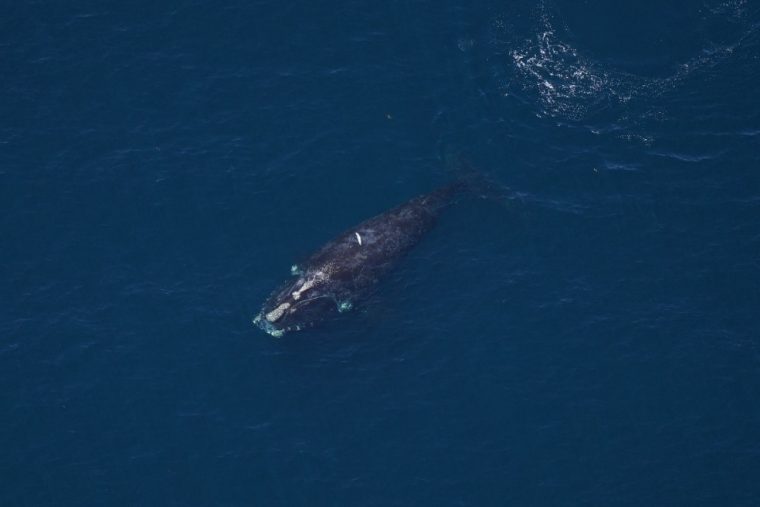New England Aquarium aerial surveys show an increasing, year-round trend of right whales in southern New England

BOSTON, MASS. (July 20, 2022) – North Atlantic right whales are returning to a historically significant whaling area in southern New England waters at a time when the rapidly warming ocean is shifting the whales’ feeding and migration patterns.
**PHOTOS AVAILABLE HERE FOR DOWNLOAD, WITH CREDIT TO NEW ENGLAND AQUARIUM**
North Atlantic right whales are a critically endangered species, with an estimated population of less than 350 individuals. In a new study led by the New England Aquarium, scientists found a significant, increasing trend in right whale abundance off Martha’s Vineyard and Nantucket and determined that right whales are now sighted in this area in every season.
“Our aerial survey team suspected that they were seeing more right whales in recent years, so we are really excited to publish a comprehensive and in-depth analysis of our data,” said the study’s lead author Orla O’Brien, an associate scientist at the Aquarium.
These waters were designated for wind energy development in 2013, with plans for the first large-scale commercial wind farm in the United States. Regular aerial surveys conducted by the New England Aquarium began in 2011 to collect data about right whale occurrence and feeding patterns. These surveys have used systematic and consistent methods since they began, which enabled the researchers to statistically document the increase in whale presence.
In the study, published in the journal Scientific Reports, the researchers used data collected from New England Aquarium aerial surveys of the southern New England shelf waters from 2013 to 2015, and 2017 to 2019. Historically, right whales were seen in this area in winter and spring. This study documented an increase in right whale abundance in this area during these seasons. The aerial surveys from 2017-2019 also documented small numbers of right whales in both summer and fall. This year-round detection of right whales in southern New England by aerial surveys is unique among major right whale habitats. The new year-round habitat use, along with the increase in winter and spring abundance, demonstrates that this region represents an increasingly important habitat for the declining population.
The team of scientists from the Anderson Cabot Center for Ocean Life at the New England Aquarium, the University of Rhode Island, Simmons University, and the Center for Coastal Studies wrote that the study’s findings highlight the need to effectively manage human activities in southern New England waters. The researchers noted that large-scale wind energy development in the area could expose right whales to the effects of construction, including noise from pile driving and increased vessel traffic. “It is acutely important to continue to monitor right whale abundance and distribution in this region to understand and mitigate the effects of wind-energy development on this critically endangered species,” the scientific team wrote.
“We know that when we encroach on right whale habitats, we put more pressure on this very vulnerable species,” O’Brien said. “Wind energy development is an important component of combating climate change, but it must be developed in a way that protects right whales. Continuing our aerial surveys will help us document the potential effects of wind energy development on whales and find solutions for minimizing these effects.”
Southern New England is not a new habitat for right whales. Whalers hunted right whales, humpbacks, and sperm whales off Nantucket and Martha’s Vineyard in the late 1600s. At that time, it was an important right whale winter and spring habitat. Whale species around the world are returning to historic whaling grounds, likely a result of the animals exploring expanded areas as their populations recover. However, researchers presume that North Atlantic right whales’ return to southern New England is likely driven by climate change.
Two recent studies by fellow New England Aquarium scientists also looked at the effect of climate change on right whale habitats. Researchers found that climate change has resulted in higher abundance of right whales in Cape Cod Bay; years with earlier springs had higher right whale abundance, suggesting that the whales may be using regional temperatures as a movement cue. Researchers also found that right whales’ peak use of Cape Cod Bay has shifted almost three weeks later over the past 20 years. These three studies contribute to our knowledge of climate-driven changes in right whale movement and habitat use, and help us ensure that they are protected in the future.
MEDIA CONTACT:
Pam Bechtold Snyder – psnyder@neaq.org, 617-686-5068
